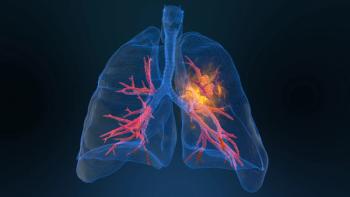
BMI Implicated in Glucocorticoid Insensitivity in CRSwNP
The investigators of this study compared outcomes between patients who had eosinophilic or noneosinophilic chronic rhinosinusitis with nasal polyps (CRSwNP) by comparing the influence of body mass index (BMI) on each disease subtype.
Novel data show how body mass index (BMI) may contribute to adverse outcomes by way of glucocorticoid insensitivity among individuals who have eosinophilic
The study cohort included 699 patients with CRSwNP—247 with glucocorticoid insensitivity and 452 with glucocorticoid sensitivity—who received care for their condition between 2010 and 2019. Two rhinologists performed bilateral, standardized, and diagnostic rigid nasal endoscopies on each patient, who were then scored via the Lund-Kennedy scoring system. Patients were included if they had no history of glucocorticoid, antibiotic, or other immunomodulatory drug use in the 4 weeks before study entry and they were classified into 4 weight categories per World Health Organization standards:
- Underweight: BMI < 18.5 kg/m2
- Normal weight: BMI ≤ 18.5 to < 25 kg/m2
- Overweight: BMI ≤ 25 to < 30 kg/m2
- Obese: BMI ≥ 30 kg/m2
“Although intranasal glucocorticoid acts as a first-line treatment for CRSwNP patients to reduce the size of nasal polyp tissue and improve nasal symptoms, the response of CRSwNP patients to glucocorticoids varies widely due to disease heterogeneity,” the study authors noted. “In overweight and obese asthmatic patients, elevated BMI leads to neutrophil infiltrations and is also associated with in vitro dexamethasone blunted response. However, whether BMI level affects glucocorticoids insensitivity in CRSwNP patients remains to be assessed.”
Most participants were male patients—78.9% of the insensitivity group, 62.6% of the sensitivity group—and classified as underweight and normal weight, at 51.8% and 62.4%, respectively. Corresponding mean baseline visual analog scale (VAS) scores (0, absence of symptoms; 10, worst severity) were 6.3 (2.0) and 6.2 (2.2) for nasal blockage, 5.3 (1.9) and 5.3 (2.0) for nasal discharge, 1.8 (2.3) and 2.2 (2.4) for facial pain, and 4.2 (3.4) and 5.1 (3.3) for smell loss.
Overweight and obese classification was shown to be an independent risk factor for glucocorticoid insensitivity in CRSwNP, with 58.4% increased odds (odds ratio [OR], 1.584; 95% CI, 1.002-2.505; P = .049). Compared with male patients, female patients had an approximate 46% reduced risk of glucocorticoid insensitivity (OR, 0.546; 95% CI, 0.328-0.910; P = .020).
When stratifying the participants by BMI and disease phenotype, patients who were considered overweight or obese and had eosinophilic CRSwNP were shown to have a greater prevalence of glucocorticoid insensitivity compared with same weight–classified patients who had noneosinophilic CRSwNP: 9.9% vs 4.2% (P < .05). Differences were not seen between the 2 CRSwNP subgroups for the underweight and normal weight participants or those classified as overweight or obese regarding infiltrated immune cells in tissues or polyp recurrence rate.
The researchers note that clinical implications of their findings are that they are novel, that their data show for the first time how being overweight or obese has potential to increase the risk of glucocorticoid insensitivity among persons living with CRSwNP.
However, they did note that a limitation on generalizability lies with ongoing uncertainty regarding if obesity affect polyp recurrence, for which they recommend analysis among a larger patient cohort. They also recommend testing the levels of obesity-related cytokines in the nasal polyp tissue samples of their study subgroups, as “BMI might influence glycocorticoid insensitivity via the level of obesity-related cytokines.”
Reference
Zhang Y, Shen S, Liu Y, et al. The influence of body mass index on glucocorticoid insensitivity in chronic rhinosinusitis with nasal polyps. J Pers Med. Published online November 21, 2022. doi:10.3390/jpm12111935
Newsletter
Stay ahead of policy, cost, and value—subscribe to AJMC for expert insights at the intersection of clinical care and health economics.






























































